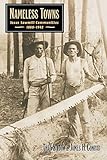Nameless Towns : Texas Sawmill Communities, 1880-1942 / James H. Conrad, Thad Sitton.
Material type: TextPublisher: Austin : University of Texas Press, [2021]Copyright date: ©1998Description: 1 online resource (271 p.)Content type:
TextPublisher: Austin : University of Texas Press, [2021]Copyright date: ©1998Description: 1 online resource (271 p.)Content type: - 9780292799882
- 976.4/06 21
- F391 .S6254 1998eb
- online - DeGruyter
| Item type | Current library | Call number | URL | Status | Notes | Barcode | |
|---|---|---|---|---|---|---|---|
 eBook
eBook
|
Biblioteca "Angelicum" Pont. Univ. S.Tommaso d'Aquino Nuvola online | online - DeGruyter (Browse shelf(Opens below)) | Online access | Not for loan (Accesso limitato) | Accesso per gli utenti autorizzati / Access for authorized users | (dgr)9780292799882 |
Browsing Biblioteca "Angelicum" Pont. Univ. S.Tommaso d'Aquino shelves, Shelving location: Nuvola online Close shelf browser (Hides shelf browser)

|

|

|

|

|

|

|
||
| online - DeGruyter Mexican American Youth Organization : Avant-Garde of the Chicano Movement in Texas / | online - DeGruyter Reinventing Texas Government / | online - DeGruyter From Can See to Can’t : Texas Cotton Farmers on the Southern Prairies / | online - DeGruyter Nameless Towns : Texas Sawmill Communities, 1880-1942 / | online - DeGruyter Women and Social Movements in Latin America : Power from Below / | online - DeGruyter The Texas City Disaster, 1947 / | online - DeGruyter Kuna Crafts, Gender, and the Global Economy / |
Frontmatter -- Contents -- Preface and Acknowledgments -- Chapter One. Introduction -- Chapter Two. Panoramas -- Chapter Three. Feudal Towns -- Chapter Four. The Cornbread Whistle -- Chapter Five. Dancing on the Millpond -- Chapter Six. Cut and Get Out -- Notes -- Bibliography -- Index
restricted access online access with authorization star
http://purl.org/coar/access_right/c_16ec
Sawmill communities were once the thriving centers of East Texas life. Many sprang up almost overnight in a pine forest clearing, and many disappeared just as quickly after the company "cut out" its last trees. But during their heyday, these company towns made Texas the nation's third-largest lumber producer and created a colorful way of life that lingers in the memories of the remaining former residents and their children and grandchildren. Drawing on oral history, company records, and other archival sources, Sitton and Conrad recreate the lifeways of the sawmill communities. They describe the companies that ran the mills and the different kinds of jobs involved in logging and milling. They depict the usually rough-hewn towns, with their central mill, unpainted houses, company store, and schools, churches, and community centers. And they characterize the lives of the people, from the hard, awesomely dangerous mill work to the dances, picnics, and other recreations that offered welcome diversions.
Mode of access: Internet via World Wide Web.
In English.
Description based on online resource; title from PDF title page (publisher's Web site, viewed 26. Apr 2022)


